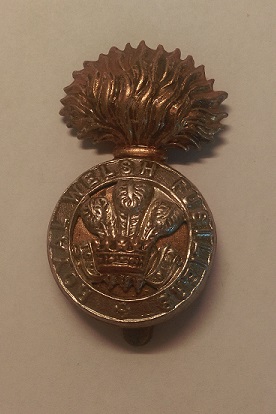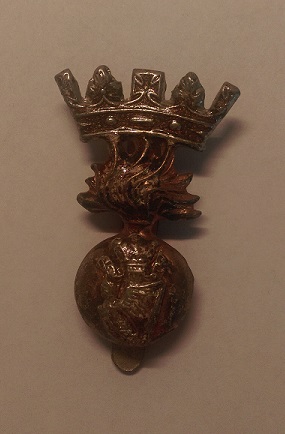
The Royal Welch Fusiliers (Welsh: Ffiwsilwyr Brenhinol Cymreig) was a line infantry regiment of the British Army, and part of the Prince of Wales's Division, that was founded in 1689; shortly after the Glorious Revolution. In 1702, it was designated a fusilier regiment and became the Welch Regiment of Fusiliers; the prefix "Royal" was added in 1713, then confirmed in 1714 when George I named it the Prince of Wales's Own Royal Regiment of Welsh Fusiliers. In 1751, after reforms that standardised the naming and numbering of regiments, it became the 23rd Regiment of Foot (Royal Welsh Fuzileers). In 1881, the final title of the regiment was adopted.
The 36th (Ulster) Division was an infantry division of the British Army, part of Lord Kitchener's New Army, formed in September 1914. Originally called the Ulster Division, it was made up of mainly members of the Ulster Volunteer Force, who formed thirteen additional battalions for three existing regiments: the Royal Irish Fusiliers, the Royal Irish Rifles and the Royal Inniskilling Fusiliers. The division served from October 1915 on Western Front as a formation of the British Army during the Great War.

The 16th (Irish) Division was an infantry division of the British Army, raised for service during World War I. The division was a voluntary 'Service' formation of Lord Kitchener's New Armies, created in Ireland from the 'National Volunteers', initially in September 1914, after the outbreak of the Great War. In December 1915, the division moved to France, joining the British Expeditionary Force (BEF), under the command of Irish Major General William Hickie, and spent the duration of the war in action on the Western Front. Following enormous losses at the Somme, Passchendaele and Ypres, the 16th (Irish) Division required a substantial refit in England between June and August 1918, which involved the introduction of many non-Irish battalions.

The Lancashire Fusiliers was a line infantry regiment of the British Army that saw distinguished service through many years and wars, including the Second Boer War, and the First and Second World Wars. It had many different titles throughout its 280 years of existence.
The Royal Irish Rangers was a regular light infantry regiment of the British Army with a relatively short existence, formed in 1968 and later merged with the Ulster Defence Regiment in 1992 to form the Royal Irish Regiment.

The Royal Irish Rifles was an infantry rifle regiment of the British Army, first created in 1881 by the amalgamation of the 83rd Regiment of Foot and the 86th Regiment of Foot. The regiment saw service in the Second Boer War, the First World War, the Second World War, and the Korean War.

The Royal Inniskilling Fusiliers was an Irish line infantry regiment of the British Army in existence from 1881 until 1968. The regiment was formed in 1881 by the amalgamation of the 27th (Inniskilling) Regiment of Foot and the 108th Regiment of Foot.

The Cameronians (Scottish Rifles) was a rifle regiment of the British Army, the only regiment of rifles amongst the Scottish regiments of infantry. It was formed in 1881 under the Childers Reforms by the amalgamation of the 26th Cameronian Regiment and the 90th Perthshire Light Infantry. In 1968, when reductions were required, the regiment chose to be disbanded rather than amalgamated with another regiment, one of only two infantry regiments in the British Army to do so, with the other being the York and Lancaster Regiment. It can trace its roots to that of the Cameronians, later the 26th of Foot, who were raised in 1689. The 1881 amalgamation coincided with the Cameronian's selection to become the new Scottish Rifles.

The 38th (Irish) Brigade, is a brigade formation of the British Army that served in the Second World War. It was composed of North Irish line infantry regiments and served with distinction in the Tunisian and Italian Campaigns. Following the end of the war, the brigade was disbanded, but was reformed in sixty years later in 2007 and remains the regional formation for Northern Ireland.
The 19th Brigade is an Army Reserve formation of the British Army. As the 19th Infantry Brigade, it fought in the First and Second World War.

The 29th Infantry Brigade was an infantry brigade unit of the British Army. It was originally raised in 1914 and saw service during the First and Second World Wars and the Korean War.

The Royal Sussex Regiment was a line infantry regiment of the British Army that was in existence from 1881 to 1966. The regiment was formed in 1881 as part of the Childers Reforms by the amalgamation of the 35th Regiment of Foot and the 107th Regiment of Foot. The regiment saw service in the Second Boer War, and both World War I and World War II.

The King's Own Royal Regiment (Lancaster) was a line infantry regiment of the British Army. It served under various titles and fought in many wars and conflicts, including both the First and the Second World Wars, from 1680 to 1959. In 1959, the regiment was amalgamated with the Border Regiment to form the King's Own Royal Border Regiment.

The Border Regiment was a line infantry regiment of the British Army, which was formed in 1881 under the Childers Reforms by the amalgamation of the 34th (Cumberland) Regiment of Foot and the 55th (Westmorland) Regiment of Foot.

The Royal Irish Fusiliers (Princess Victoria's) was an Irish line infantry (later changed to light infantry) regiment of the British Army, formed by the amalgamation of the 87th (Prince of Wales's Irish) Regiment of Foot and the 89th (Princess Victoria's) Regiment of Foot in 1881. The regiment's first title in 1881 was Princess Victoria's (Royal Irish Fusiliers), changed in 1920 to the Royal Irish Fusiliers (Princess Victoria's). Between the time of its formation and Irish independence, it was one of eight Irish regiments.

The 7th (Meerut) Division was an infantry division of the Indian Army and before 1895, the Bengal Army, that saw active service during World War I.
233rd Brigade was an infantry formation of the British Army in the First and the Second World Wars

The 140th Brigade was an infantry brigade formation of the British Army's Territorial Army (TA) that had its origins in a South London Brigade of the former Volunteer Force. It served on the Western Front in the First World War and was recreated during the Second World War where it served only in the United Kingdom as a training formation.

The 141st Brigade was an infantry brigade of the Territorial Army, part of the British Army, that served in the First World War and remained in the United Kingdom throughout the Second World War.
Frank Percy Crozier was a British military officer. His first military experience was in the Second Boer War (1899–1902) and with the Royal West African Frontier Force in Nigeria. During World War I, he commanded the 9th (Service) Battalion of the 107th (Ulster) Brigade in the Battle of the Somme earning him the promotion to brigadier general and command of the 119th (Welsh) Brigade in the Battle of Cambrai and German spring offensive.














